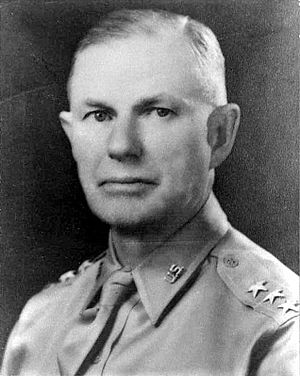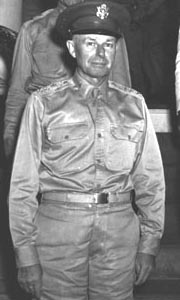Walter Short facts for kids
Quick facts for kids
Walter Campbell Short
|
|
|---|---|

Lieutenant General Walter C. Short
|
|
| Born | March 30, 1880 Fillmore, Illinois, U.S. |
| Died | September 3, 1949 (aged 69) Dallas, Texas, U.S. |
| Allegiance | |
| Service/ |
|
| Years of service | 1902–1942 |
| Rank | Lieutenant General |
| Commands held | 1st Infantry Division I Corps Hawaiian Department |
| Battles/wars | World War I World War II |
| Awards | Army Distinguished Service Medal |
Walter Campbell Short (born March 30, 1880 – died September 3, 1949) was an American Army officer. He held the rank of lieutenant general (a temporary rank) and later major general. He was in charge of defending U.S. military bases in Hawaii when Japan attacked Pearl Harbor on December 7, 1941.
Contents
Early Life and Education
Walter Short was born in 1880 in Fillmore, Illinois. His father was a doctor. Walter graduated from the University of Illinois in 1901. After college, he taught math at a military academy for one year.
Military Career
Before World War II
Short joined the U.S. Army as a second lieutenant on March 13, 1902. He was first stationed at the Presidio of San Francisco. He served in the Philippines and Alaska. In 1916, he joined an expedition into Mexico with the 16th Infantry Regiment.
During World War I, he worked on the general staff of the 1st Division. He also served as assistant chief of staff for the 3rd Army.
After the war, Short worked with the Military Intelligence Division until 1924. He then attended the United States Army War College. After graduating, he became an instructor there. From 1938 to 1940, he commanded the 1st Infantry Division. From January 1940 to January 1941, he led I Corps.
Leading the Hawaiian Department
General George Marshall chose Short to lead the Hawaiian command on February 8, 1941. Short had a very successful career. He received the Distinguished Service Medal. He was promoted several times during peacetime, which was a great achievement.
The Attack on Pearl Harbor
On December 7, 1941, the Japanese military launched a surprise attack on Pearl Harbor in Hawaii. This attack severely damaged the U.S. Pacific Fleet. It also destroyed many U.S. Army aircraft. At the time, General Short was responsible for the Army's defenses in Hawaii.
What Happened After the Attack?
On December 17, 1941, General Short was removed from his command. Army Chief of Staff George C. Marshall ordered him back to Washington, D.C. Short's temporary rank of lieutenant general was tied to his command. So, he returned to his permanent rank of major general.
On February 28, 1942, he retired from the Army. He then worked as the head of the traffic department at a Ford Motor Company plant in Dallas, Texas. He briefly returned to active duty from October 1945 to February 1946. He retired again in 1946. Walter Short died in 1949 in Dallas from a heart problem.
The Roberts Commission Investigation
Soon after the attack, the Roberts Commission was formed. It was led by U.S. Supreme Court Justice Owen J. Roberts. This commission investigated the attack. General Short and Navy Admiral Husband E. Kimmel were accused of not being ready. The report said they did not take an earlier war warning seriously enough. It also stated they did not prepare for an air attack on Pearl Harbor.
In January 1941, Navy Secretary Frank Knox wrote to War Secretary Henry L. Stimson. Knox warned that a war with Japan might start with a surprise attack on the fleet at Pearl Harbor. He listed the biggest dangers as air bombing and air torpedo attacks. Knox urged the Army to prepare for such an attack. He also suggested that the Army and Navy work together more closely.
Stimson replied in February 1941. He said he sent a copy of Knox's letter to General Short. He told Short to work with the Navy to make the suggested defenses happen. Both Admiral Kimmel and General Short received these letters.
The Roberts Commission report found that if orders had been followed:
- The Army's aircraft warning system should have been working.
- The Army's air patrol should have been looking for distant threats.
- The Army's anti-aircraft guns should have been ready with ammunition.
- Aircraft should have been in a high state of readiness.
The report concluded that these things did not happen. This was because the commanders did not work together. They also did not follow orders from their leaders in Washington.
It's important to know that the Roberts Commission was a fact-finding investigation. It was not a court-martial or a legal trial. People involved did not have the right to a lawyer or to question witnesses. Admiral William Harrison Standley, who was on the commission, later disagreed with the report. He said that Short and Kimmel were "martyred." He believed they would have been found innocent if they had been put on trial.
General Short's Explanation
In 1946, Short spoke to Congress about the 1941 attack. He explained his actions. Unlike some other commanders in Hawaii, Short was more worried about sabotage. He feared Japanese-Americans on Oahu might try to damage military property. Because of this, he had Army planes parked close together outside their hangars. This made them easier to guard. However, it also made them easy targets for bombing. Many planes were destroyed on the morning of the attack.
General Short explained why he only ordered an alert against sabotage (called "Alert One"). He said:
- The war warning message he got on November 27 did not tell him to prepare for an air raid or a full attack on Hawaii. (Those would have been "Alert Two" or "Alert Three.")
- Other messages after November 27 focused on preventing sabotage.
- The message seemed to tell him to avoid war at all costs. He felt the War Department was most afraid of an incident in Hawaii that Japan might see as an act of war.
- He expected the Navy to warn him about any approaching enemy forces. He believed distant scouting was the Navy's job.
- Ordering higher alerts would have stopped the Hawaiian Department's training missions.
Short also stated that he did not receive enough warning. He also felt he lacked the necessary resources. He and his family tried to get the Army to give him back his rank of lieutenant general in retirement. They argued that the warnings from the War Department before the attack were unclear and confusing. He asked for a formal court-martial, but it was not granted.
1999 Senate Resolution
On May 25, 1999, the United States Senate passed a resolution. This resolution said that Kimmel and Short had done their jobs "competently and professionally." It also stated that the Japanese attacks were "not a result of dereliction of duty." Senator William V. Roth, Jr. said they were "denied vital intelligence" and had been made scapegoats. Senator Strom Thurmond called them "the two final victims of Pearl Harbor." The resolution asked President Bill Clinton to restore Kimmel and Short to their full wartime ranks. However, neither Clinton nor any later presidents acted on this resolution.
Awards
| Army Distinguished Service Medal | ||
| Mexican Border Service Medal | World War I Victory Medal with three stars |
American Defense Service Medal with "Foreign Service" clasp |
| Asiatic-Pacific Campaign Medal with one star |
World War II Victory Medal | Legion d'Honneur (Officier) (France) |
Dates of Rank
| No insignia in 1901 | Second Lieutenant, Regular Army: February 2, 1901 |
| First Lieutenant, Regular Army: April 4, 1907 | |
| Captain, Regular Army: July 1, 1916 | |
| Major, National Army: August 5, 1917 | |
| Lieutenant Colonel, Temporary: July 30, 1918 | |
| Colonel, Temporary: November 7, 1918 | |
| Captain, Regular Army: August 26, 1919 | |
| Major, Regular Army: July 1, 1920 | |
| Lieutenant Colonel, Regular Army: October 6, 1923 | |
| Colonel, Regular Army: October 1, 1933 | |
| Brigadier General, Regular Army: December 1, 1936 | |
| Major General, Regular Army: March 1, 1940 | |
| Lieutenant General, Temporary: February 8, 1941 | |
| Major General, Regular Army: December 17, 1941 | |
| Major General, Retired List: February 28, 1942 |
See also
 In Spanish: Walter Short para niños
In Spanish: Walter Short para niños


